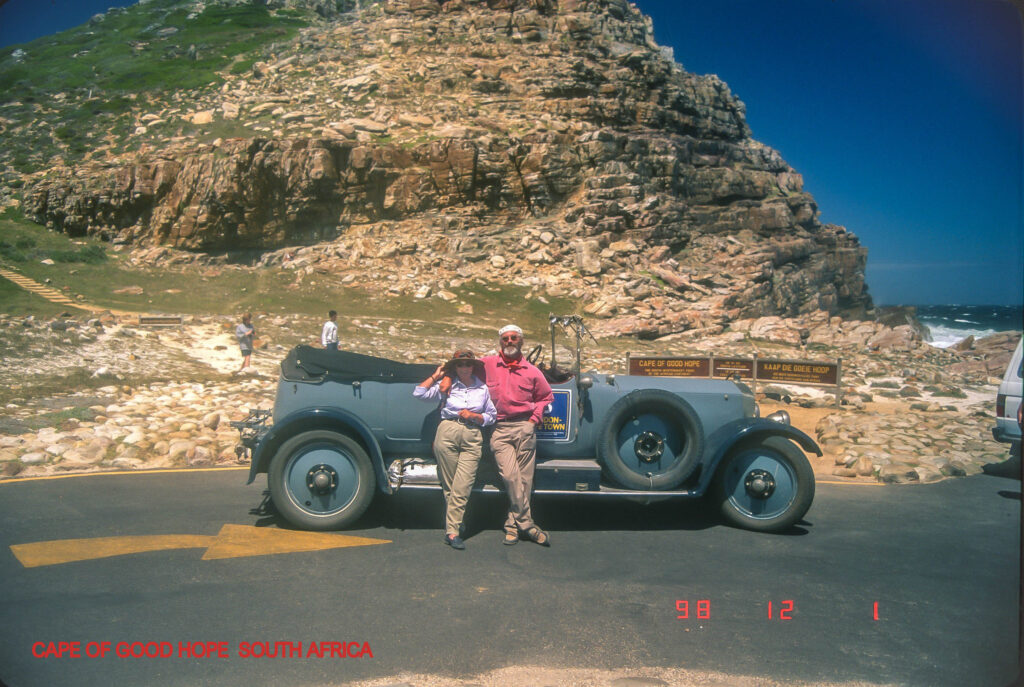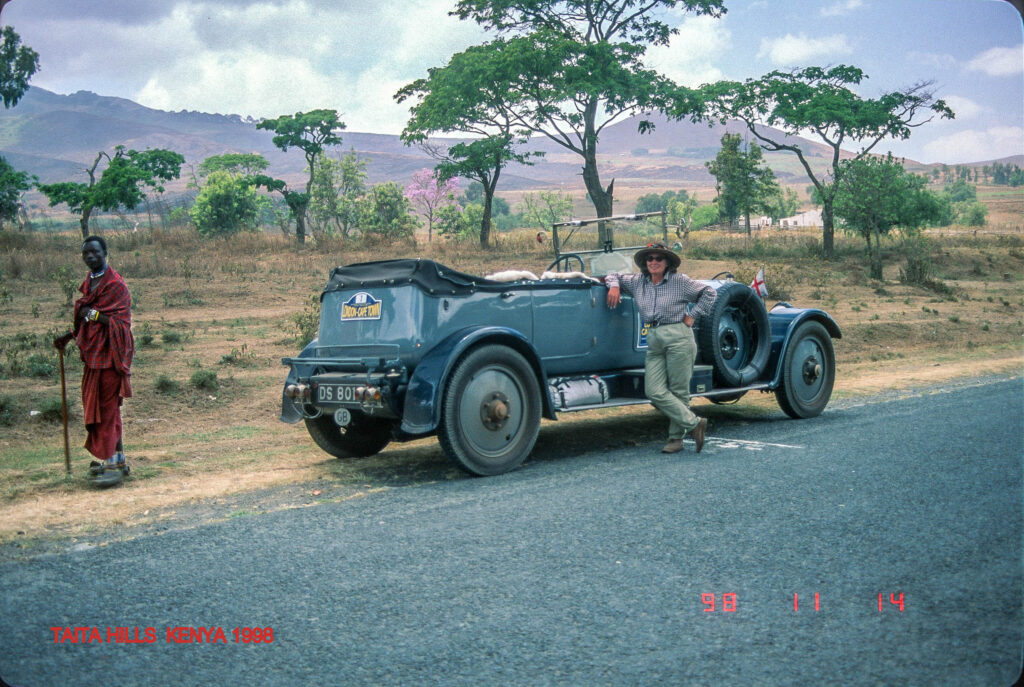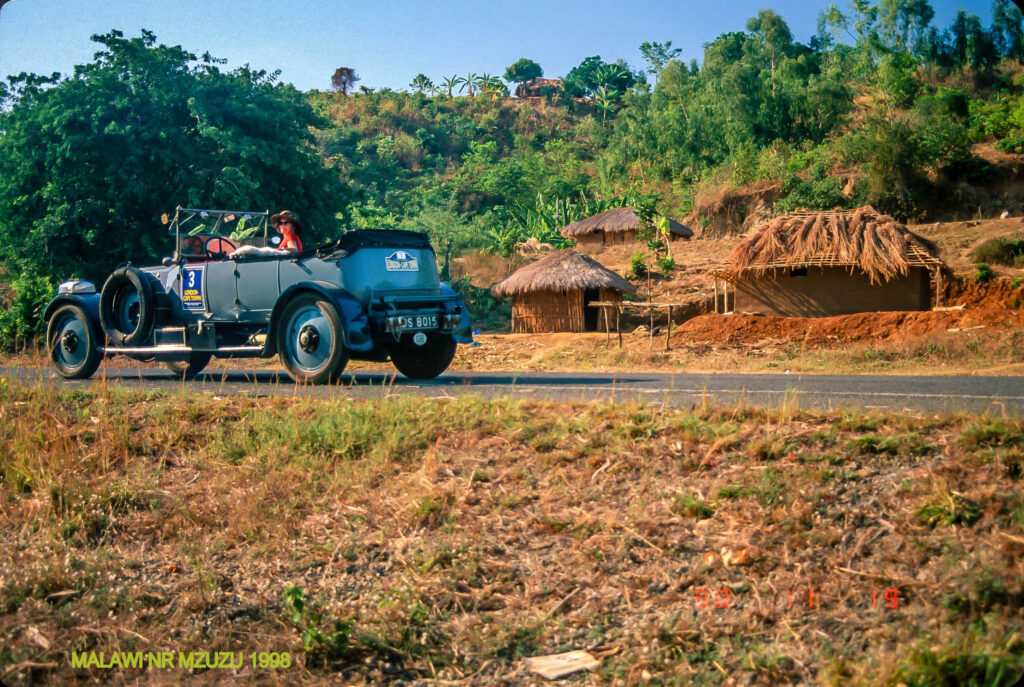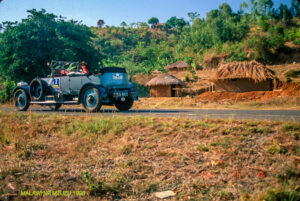A fragment: Namibia
Our 40 horse Lanchester had performed perfectly so far on the London to Cape Town rally so much so that I wanted to pet it by giving it a full service and complete cleaning before leaving the comfortable Windhoek hotel.
With 9.½ gallons of engine coolant, 4.½ gallons of engine oil, 2 gallons of gearbox oil, 1. ½ gallons of rear axle oil, ½ gallon of oil supplying the P.A.S. pump unit I had had fitted to alleviate the parking effort, and all topped off with 37 gallons of fuel, our 3.¼ ton motor car was a heady cocktail bouncing down the dirt roads of Africa.
We also of course carried about 5 gallons of drinking water; a large enough quantity so that some of it might be useful should the radiator leak. A sufficient quantity of top up oils for the aforementioned mechanical units and we were carrying 25 litres of a fuel additive recommended by Red Line Lubricants. This I had ordered in very well made stainless steel canisters with a brass threaded bung of a type one could carry as air cargo provided the bungs were sealed with wire passed through the appropriate lugs on the bung and tin. I always, when using the additive, put on rubber gloves and poured the additive into a filling tank during refuelling, but not breathing as I did so: the product contained both Benzine & Toluene: known carcinogens. Those discarded canisters were immediately snatched by one of the natives who seem to have nothing better to do than hang around fuel stations all day. To my horror after refueling the car and having it washed the recipient of one of those canisters came back drinking from it a local made beer! But he did it with such panache, I hadn’t the heart to admonish him!
We had broken a wheel, and these on a 40 horse Lanchester are ¼” boiler plate steel discs of 23”diameter: none of your elegant and namby pandy spokes here. The damage had occurred on the dreadful road between Lilongwe in Malawi to Lusaka in Zambia. This had been promoted by the organizers of the rally to be 350 miles of driving hell even for a Land Rover! Somewhere near Juma on the T4 I hit one almighty pothole but by swerving only the rear left wheel took the impact producing an explosion which shocked us. I really though we must have broken the axle or the chassis frame. The road of hard tarmac is cratered across its width for 300 miles and is therefore a much more punishing surface than any neglected dirt variant. A local quantity surveyor we met put the damage down to the lorries bleeding off a few litres of contaminated diesel which was a frequent event. The diesel, he thought, with help from the hot sun dissolved the tar which binds the aggregate and pretty soon a pothole arrived. No doubting that this is a partial view, to help disguise the inevitable corruption that eats away at the quality of all constructions here.







Our damage was a shredded tyre and a tube, a disc wheel with a cheese shape wedge cut into it and a never to be found wheel split rim, a heavy sprung 1”X24”dia. circlip which holds the tyre to the wheel. Once set free on impact, it had scythed its way into the bush only ever to be found, perhaps, by future Chinese prospectors. Thankfully it occurred in the Bush proper where nobody was about. A major Rally accident had occurred in Tanzania involving an American driver and a local girl: that was a dreadful mess and apart from the injury one enters a morass of police and legal niceties!
Sickened by the relentless onslaught of this rally and overcrowding at the hotels we, with Gerry Leuman (4.1/2litre ’27 Bentley) and the Holley’s ( ’47 Cadillac) had broken away and taken our own route and hotels after Lusaka, and they, wanting to see the Skeleton Coast, decided to re-join the Rally at Walvis Bay direct from Windhoek. This they later discussed as being about the worst decision they had taken since joining this Rally.
The accommodation at Walvis Bay had been a hastily erected set of old army marquees each sub-divided into separate quarters by transparent hessian, more suitable for a coconut shy at a country funfair than screening. The wind on that coast is gale-force and with sea currents up from the Antarctic the evenings and nights are miserable.
We, after an additional day of planned stay in Windhoek, intended then to go direct to Canyon Lodge at Fish River, just before the border with South Africa. That journey would be south on dirt for about 400 miles. So on the morning of our day off I removed everything from the car up to the room so that Susie could repack, tidy up the picnic set, the camping equipment and sort out the boxes of maps and rally notes. She also organized the laundry and booked a special meal; marinaded leg of Springbok for the evening meal while I went down to the car to lovingly service it with the sun on my back.

I primed all 52 grease nipples and 22 oil sinks, adjusted the carburettors, re gapped the 12 spark plugs, then leisurely strobed the ignitions, mag and coil, before going out for an engine oil change. That being done I had the car thoroughly washed and at a petrol station about a mile from the hotel filled up with 33 gallons of fuel. As African pump attendants will always fill to the very brim or just beyond it, I was not surprised to smell a heavy petrol vapour on the short return drive.
Back at the hotel car park there was little to do now in preparing the car for the morrow. So I checked the tyre pressures, jacked up each wheel to adjust the brakes but could not get away from that heavy crude smell of petrol which should not have persisted, especially as the ambient temperature was in the high 40s and there was a gentle though persistent westerly wind!
Now I began the search for a petrol leak which must surely be, I thought, either a dirty float valve, a loose banjo bolt on the carbs or a compression joint seeping somewhere on the fuel line, maybe even from the petrol pumps tucked away into the chassis U section at the rear.
And so the bonnet came off as did the tonneau and the tool boxes, the seats came out, the carpets were removed and the floor boarding came up too: also the below floor spares tray, 3 foot square 7”deep, came out with lots of helpful cursing, but there was no sign of a leak anywhere. Yet the smell persisted and was getting stronger rather than fainter as would be expected without the engine running or the car moving.
Lanchester had fitted a 20 gallon tank between the chassis rails at the rear and for the export model, and ours was 1of 7 left hand drive cars made, an additional 10 gallon reserve tank was fitted behind the rear seat cushion within the bodywork leaving the luggage rack free for cases. To operate this tank one simply turned a lever in front of the rear seat kick board which operated a gate valve and the contents drained into the main tank without recourse to a pump: simplicity. To enable us to drive the 400 miles between petrol stops as demanded by rallies in Central Asia I had had a larger reserve tank made and fitted with an increase to 17 gallons.
Checking the auxiliary tank by pulling the rear seat cushion forward I immediately saw in the dark cavern below a mirror image of my own face and the blue sky! This auxiliary tank being taller than the original had been unable to take the torsional stresses caused by the flexing of the chassis: perhaps the result of that potholed road to Lusaka! The soldered and riveted internal baffles, placed there to stop the sloshing effect on cornering, had pulled through. Petrol was coursing down the tank walls and gathering to form a puddle inside the body behind the rear seat.
The obvious solution was to drain the tank but we needed its extra capacity and buying loose jerry cans of 20 Ltrs was not a solution as they are a serious liability on bumpy roads besides there was no room for four of these as we always travelled with too much luggage, too many spares, and far too many tools. But I had to act swiftly: this was an incendiary about to explode.
What to do? One thing was certain we could not leave the car parked overnight as the friendly, if not eager, onlookers who, all avid smokers made me greatly fear a fire. Telling them to keep back or put their cigarettes out was not working and so I reassembled the car and rushed across to reception explaining my predicament and requesting a security man to keep the smokers well back while I ran upstairs to collect Susie, delegating to her to pack our luggage, to cancel the much desired evening meal, to find the unwashed laundry and make a booking at the nearest hotel going south which would be in Keetmanshoop 360 miles away.
We pulled out of the hotel car park at 15.15 hrs. with the intention of burning off the fuel in the auxiliary tank and evaporating that little pond of petrol that was sloshing around in the back of the bodywork.
Now began one of the greatest drives of our lives.
Pretty soon the black-top tarmac road ceased as we came to the outskirts of town and a fairly smooth but dusty white chalk desert road ran out before us south. This was going to be, at first glimpse, a long and anxious drive. We took some comfort from the proprietor at Keetmanshoop, when he had said our chances on the road were fair, as, “we still had all kinds of daylight left”: more comforting was that the hotel would accept us even past midnight.
It was still hot and after the initial climb out of Windhoek the road continued to climb more gently for the next 150 miles but after about 70 miles a really powerful headwind assaulted us and for anybody familiar with the architecture of the Lanchester 40 h p tourer they will know that it has a lot in common by design with that fragment of the Berlin Wall: its upright flat windscreen, 22×50”is a great comfort for the driver and passenger, but acts as an air dam, as does the massive flat faced radiator, the 10”dia. headlamps etc.. My foot was flat on the floor for the entire journey varying in speed between 50 and 53 mph. Meanwhile the petrol fumes had given us both a headache and though we had a headwind this only served to produce more of a low pressure area behind the screen and dashboard whereupon the petrol vapours were sucked forward from under the tonneau cover and then straight up in front of our faces: any little blue spark now might produce a magnificent film clip for any of those modern American film makers who can think of no other dramatic gesture than cars somersaulting in at speed engulfed in flames!
So the top sections of the front screens were opened, the tonneau removed and the back seat cushion held forward with 2 bungee cords: fresh African evening air now cleared our heads but the headwind was even more of a serious handicap to our speed.
Presently we came upon a plume of thick dust; it was from a lorry in the far distance going south as we were. It took a while but we finally caught him up on the top of the escarpment where the heavy hard sand and rock road surface reduced the dust down to almost tarmac standards. After following for a little while I now put my accelerator fully to overtake, but as soon as I was out of the slip-stream it seemed as if the hand brake had been fully applied: we were hitting that headwind again and just did not have sufficient power to pass what turned out to be a 3-trailer-road-train. We could only follow now and probably all the way to Mariental, the only town on that road.
By dropping back and then pulling forward in the road trains wake we adjusted our distance to a point where the buffeting was minimal and where there was hardly any need to use the full power of the engine but we ate dust as never before. We did now though have the chance to relax and enjoy the desert on both sides of the road, watching the big predator birds perched on the old telegraph poles or the occasional antelope herd.
Susie closed her front screen first and then I closed mine with the realization and relief that the petrol vapours had stopped: the little petrol pond had evaporated and the auxiliary tanks contents had been consumed, and so with our anxieties gone about a fire or explosion or major migraine from our own petrol additives we could watch the giant shadow of our truly heroic car being cast onto the white sandy desert to our left.